Credit risk
NPL significantly lower
than the banking sector
average
Credit risk is the risk assumed by the Group under credit transactions and resulting in its inability to recover the amounts disbursed, loss of income or a financial loss. It is the outcome of credit product development and launch as well as the lending process on the one hand and measures employed with a view to reducing the probability of losses, on the other. The Group’s credit risk includes both counterparty and settlement risk.
While developing its current credit risk management policy, the Group aims to maintain the risk appetite defined in its strategy and measured with the NPL ratio and the specified cost of risk as well as an appropriate level of equity, comply with the credit limits adopted by the Bank, analyze both strengths and weaknesses of the Group’s lending process and anticipate the opportunities and threats for its further growth. The Group’s acceptable credit risk policy also takes into account cyclicality of economic processes and changes in the credit portfolio itself.
The Group has reviewed methodologies and all parameters in order to adapt them to changing market conditions.
The following principles have been adopted for the credit risk management process:
- Analyzing credit risk of individual exposures, the credit portfolio and the capital requirement related to credit risk;
- Using internal and external limits determined by the risk appetite in various areas of the credit portfolio, the Banking Law and recommendations of the Polish Financial Supervision Authority, respectively. The types and levels of the limits used by the Group with regard to lending are determined by internal regulations on credit limits related, among other things, to large exposure concentration, industry concentration, exposure concentration based on type of collateral and product;
- Functions related to direct analysis of applications, risk assessment and credit related decision making are separated from those focused on client attraction (sales of banking products);
- Credit capacity and creditworthiness are the main criteria underlying all credit transactions with clients;
- Credit decisions are made in the Group in accordance with procedures and competencies determined in internal regulations on credit risk assessment and credit decision making;
- Each credit transaction is monitored from its conclusion to full settlement in terms of utilization, timely repayment, legal security, equity and organizational relationships of the obligor and, in the case of institutional clients, also in terms of their current economic and financial position;
- The financial and economic standing of each insurance company supplying credit collateral, as well as delivery of insurance policies and assignment of rights related thereto by clients are monitored on a regular basis;
- Developments in the real estate market as well as the legal and economic assumptions and framework for valuation of property provided as collateral for credit exposures are monitored on a periodic basis.
Credit risk management in the Group is based on written policies and procedures defining methods of identification, measurement, monitoring, limiting and reporting of credit risk. At least once a year, the Bank reviews and verifies these instructions, procedures and credit risk limits. The regulations determine the scope of
competencies assigned to each unit of the Bank in the credit risk management process.
In order to determine the credit risk level, the Bank uses the following measures:
- Probability of default (PD);
- Recovery rate (RR);
- Share and structure of impaired loans (NPL);
- Coverage of impaired loans with impairment losses (NPL coverage);
- Scoring model efficiency measures (among others GINI, PSI Ratio);
- Cost of risk.
The Bank prepares the following cyclical reports on its exposure to liquidity risk:
- Monthly report for the Management Board and Credit Committee of the Bank;
- Quarterly report for the Supervisory and Management Board.
Portfolio quality
At the end of December 2014 the share of impaired exposures in the credit portfolio was 6.1% and was 0.7 p.p. higher than a year before
Portfolio quality – the share of impaired loans and advances in the gross credit portfolio (%)
| 31.12.2014 | 31.12.2013 | Change 2014/2013 |
|
|---|---|---|---|
| Capital Group total | 6.1% | 5.4% | 0.7 p.p. |
| For individuals | 5.6% | 4.7% | 0.9 p.p. |
| For institutional clients | 13.0% | 12.3% | 0.7 p.p. |
| For self-government bodies | 0.0% | 0.0% | 0.0 p.p. |
Portfolio quality – gross impaired loans (PLN’000)
| 31.12.2014 | 31.12.2013 | Change 2014/2013 |
|
|---|---|---|---|
| Capital Group total | 325,391 | 277,241 | 48,150 |
| For individuals | 247,265 | 193,465 | 53,800 |
| For institutional clients | 78,026 | 83,776 | (5,750) |
| For self-government bodies | 100 | 0 | 100 |
The NPL growth resulted from the consumer loan loss ratio being higher than in the prior year. Please note that the NPL level recorded at the end of 2014 is lower than the risk appetite level accepted by the Group. Further, quality of the Group’s loan portfolio was considerably higher than the banking sector average, which at the end of 2014 demonstrated NPL of 8.1%1.
Loans and advances to institutional clients demonstrated the highest NPL both at the end of 2014 and 2013. The increase in the loss ratio in 2014 for these receivables resulted mostly from the portfolio gradually reaching its maturity accompanied with phasing out of new lending. In December 2014, NPL for real property consumer loans and for loans for selfgovernment institutions remained on the level recorded in 2013.
NPL value for loans and advances (%)
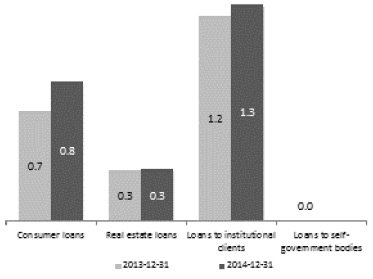
Impairment loss
At the end of 2014 impairment losses for the Group’s credit portfolio amounted to PLN 173.9 million and were 39.4% higher than at the end of 2013.
The total impairment loss included the loss on impaired exposures of PLN 150.2 million and incurred but unreported losses (IBNR) of PLN 23.7 million. The highest increase in impairment losses was seen in the consumer loan segment (PLN 31.1 million) and in the institutional client segment (PLN 12.5 million).
Impairment losses on originated loans and advances (PLN MM)
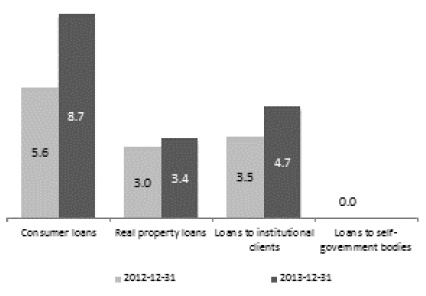
Bank total
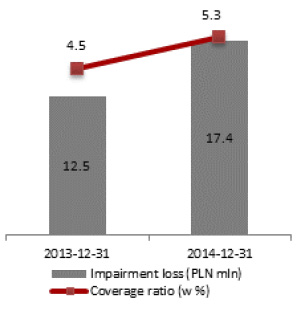
Individuals
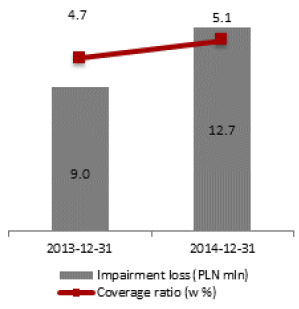
Institutional clients
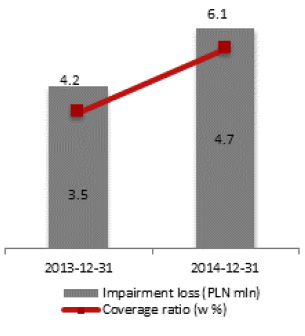
The total impairment loss included the loss on impaired exposures of PLN 150.2 million and incurred but unreported losses (IBNR) of PLN 23.7 million. The highest increase in impairment losses was seen in the consumer loan segment (PLN 31.1 million) and in the institutional client segment (PLN 12.5 million).
Index:
1 Source: NBP, Section: Banking sector financial data, file Receivables.
Annual Report 2014 - Bank Pocztowy
Corporate Governance
- Corporate governance: principles and scope of application
- Control system in the process of preparing financial statements
- Entity authorized to audit financial statements
- Shareholding structure and share capital
- Key information regarding Poczta Polska S.A.
- Cooperation with Poczta Polska S.A.
- Investor relations
- By-laws amending principles
- Activities of the corporate bodies of the Bank





